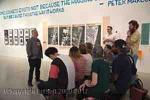Martha Rosler
Martha Rosler
Style: Op Art;
Born: 1943
Biography:
Martha Rosler is an American artist. She works in photography and photo text, video, installation, sculpture, and performance, as well as writing about art and culture. Rosler’s work is centered on everyday life and the public sphere, often with an eye to women's experience. Recurrent concerns are the media and war, as well as architecture and the built environment, from housing and homelessness to places of passage and systems of transport.
Born in Brooklyn, New York, in 1943, Rosler spent formative years in California, from 1968 to 1980, first in north San Diego county and then in San Francisco. She has also lived and taught in Canada. She graduated from Erasmus Hall High School in Brooklyn, as well as Brooklyn College and the University of California, San Diego (1974). She has lived in New York City since 1981.
Rosler's work and writing have been widely influential. Her media of choice have included photomontage and photo-text, as well as video, sculpture, and installation. Rosler has lectured extensively, nationally and internationally. She taught photography and media, as well as photo and video history and critical studies, at Rutgers University, in new Brunswick, New Jersey, where she was a professor for thirty years, attaining the rank of Professor II. She also taught at the Städelschule in Frankfurt, Germany, as well as serving as visiting professor at the University of California's San Diego and Irvine campuses, and elsewhere.
Rosler serves in an advisory capacity to the departments of education at the Whitney Museum of American Art and the Museum of Modern Art, and at the Center for Urban Pedagogy (all New York City). She is a Board Member of the Vera List Center for Art and Politics at the New School, New York and an Advisory Board board member of the Center for Urban Pedagogy. She has also served on the board of directors of the Temple Hoyne Buell Center for the Study of American Architecture at Columbia University, New York, and she is a former member of the boards of directors of the Association for Independent Video and Film and the Media Alliance, and a former trustee of the Van Alen Center, all in New York City. Since the early 1980s she has been a regular lecturer at the Whitney Independent Study Program in New York, where she was formerly a faculty member.
Rosler is known for her writing as well as her art work in various media. She has published over 16 books of her artwork and her critical essays on art, photography, and cultural matters, some of which have appeared as well in translation. Her essays have been widely published, anthologized, and translated.
Semiotics of the Kitchen (1974/75) is a pioneering work of feminist video art in which, parodying early television cooking shows, Rosler demonstrates some hand tools of the kitchen in alphabetical order. As her gestures begin to veer into an unexpected and possibly alarming direction, the character eventually dispenses with the tools and uses her body as a kind of semaphore system. Rosler has suggested that this darkly humorous work is meant to challenge social expectations of women in regard to food production and, more broadly, the role of language in determining these expectations. The issue the work calls up is whether the woman can be said to "speak herself."
Further video works include Vital Statistics of a Citizen, Simply Obtained (1977), Losing: A Conversation with the Parents (1977), and Martha Rosler Reads Vogue (1982), with Paper Tiger Television; Domination and the Everyday (1980) and Born to Be Sold: Martha Rosler Reads the Strange Case of Baby $/M (1988), also with Paper Tiger Television. Many of her video works address geopolitcs and power, including Secrets From the Street: No Disclosure (1980); A Simple Case for Torture, or How to Sleep at Night (1983); If It's Too Bad to be True, It Could Be DISINFORMATION (1985); the three-channel installation Global Taste: A Meal in Three Courses (1985); and Because This Is Britain (2014), and many others.
Rosler employs performance-based narratives and symbolic images of mass media to disrupt viewers' expectations. Rosler says, "Video itself 'isn't innocent:' Yet video lets me construct, using a variety of fictional narrative forms, 'decoys' engaged in a dialectic with commercial TV."
These concepts are emphasized in such works as Semiotics of the Kitchen, in which a static camera is focused on a woman in a kitchen who interacts with kitchen utensils, naming and demonstrating their uses in odd gestures, speaking to the expectations of women in certain domestic spaces.
Rosler's photo/text work The Bowery in two inadequate descriptive systems (1974/75) is considered a seminal work in conceptual and postmodern photographic practice. The series of 45 black and white prints pair photos of storefronts on the Bowery, at the time of the work's making a famous "skid row" of New York City, with photographs of mostly metaphoric groups of texts referring to drunks and drunken behavior. The photos are displayed in a grid to accentuate the anti-expressionist nature of the work and the inherent limitation of both visual and linguistic systems to describe human experiences and social problems.
More...
Wikipedia link: Click Here














